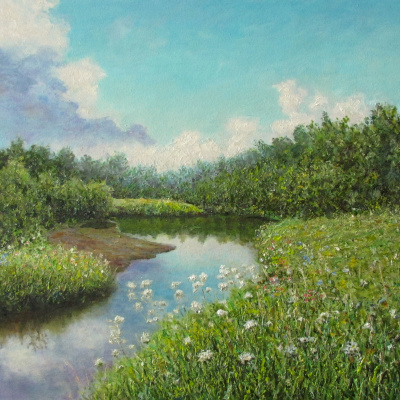In this article we will detail what the sponge painting technique in art is and define sponge technique. We will also look at the sponge painting technique on the examples of the works of famous artists.

Sponge painting technique
Finishing with sponge technique painting has become very popular because it looks stylish and relevant. In particular, if you follow the optimal color scheme, and allow yourself to update combinations of shades. Finishing with staining with a sponge will be an excellent solution from home.This is because applying paint has become much faster and easier. There is no need to spend money on additional tools and materials. Everything you need can be found in the paint shop. If you apply the paint with a sponge, you can achieve a textured finish.
It not only looks stylish and decorative. The sponge staining technique has other advantages, including:
- Masking of defects that are present on the surface. This is a great solution if you need to paint old walls that are in poor condition. In this case, you can cheaply replace drywall.
- Concealing dirt, including stains in the kitchen or the children's room.
- The possibility of using equipment in places where there is quite active traffic. This is because oil paints are used, which are durable. If you need to correct patterns, then this can be done quickly and easily.
You can use acrylic sponge painting or sponge faux painting on any flat surface, even if it has already been painted. This applies to walls, floors, and furniture. Shades can be light or bright. You can adapt the technique to any style of interior.
The result that you will notice at the end depends on the pigments, transparency, as well as glossiness of the coating. You can also vary the density of the layer. The easiest way to work is with a marine sponge, which allows you to quickly apply paint to the surface.
You can use a sponge to create various spots that will differ in effect. You can also create irregularly shaped patterns. If everything is done correctly, you can achieve a mottled texture. Therefore, all prints will be different from each other, creating a unique pattern.
The result that you will notice at the end depends on the pigments, transparency, as well as glossiness of the coating. You can also vary the density of the layer. The easiest way to work is with a marine sponge, which allows you to quickly apply paint to the surface.
You can use a sponge to create various spots that will differ in effect. You can also create irregularly shaped patterns. If everything is done correctly, you can achieve a mottled texture. Therefore, all prints will be different from each other, creating a unique pattern.
Examples of sponging painting techniques in art
The sponge painting technique was one of the first and is considered an excellent option for decorative painting. It gained its greatest popularity in the 80s of the last century. After that, people began to refuse to apply contrasting colors with a sponge, because the technique was considered rather rough.Sponge brush painting is used not only in home decoration. It can be used for the development of children, as well as to create beautiful paintings on canvas. It all depends on your imagination
















